Globalization and Value Chain Management
VerifiedAdded on 2023/06/05
|9
|2765
|392
AI Summary
This essay critically analyzes an article by Pankaj Ghemawat, entitled, “Globalization in the Age of Trump’(2017). The aim of the essay is to weigh the pros and cons of such a policy. The essay concludes with the argument that the withdrawal from globalization is something that stands to harm not only international trade and commerce but the economic health of the United States of America too.
Contribute Materials
Your contribution can guide someone’s learning journey. Share your
documents today.
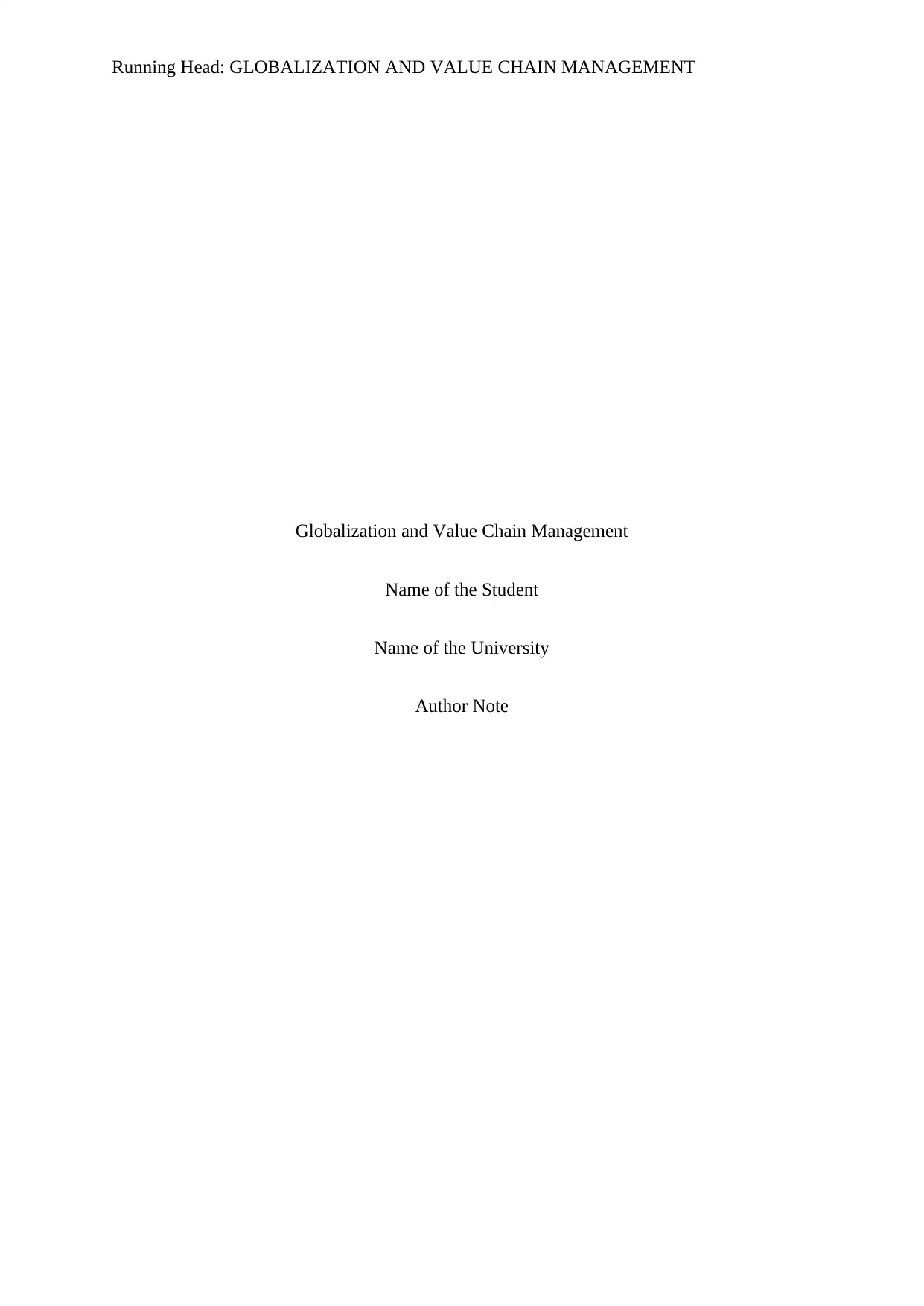
Running Head: GLOBALIZATION AND VALUE CHAIN MANAGEMENT
Globalization and Value Chain Management
Name of the Student
Name of the University
Author Note
Globalization and Value Chain Management
Name of the Student
Name of the University
Author Note
Secure Best Marks with AI Grader
Need help grading? Try our AI Grader for instant feedback on your assignments.
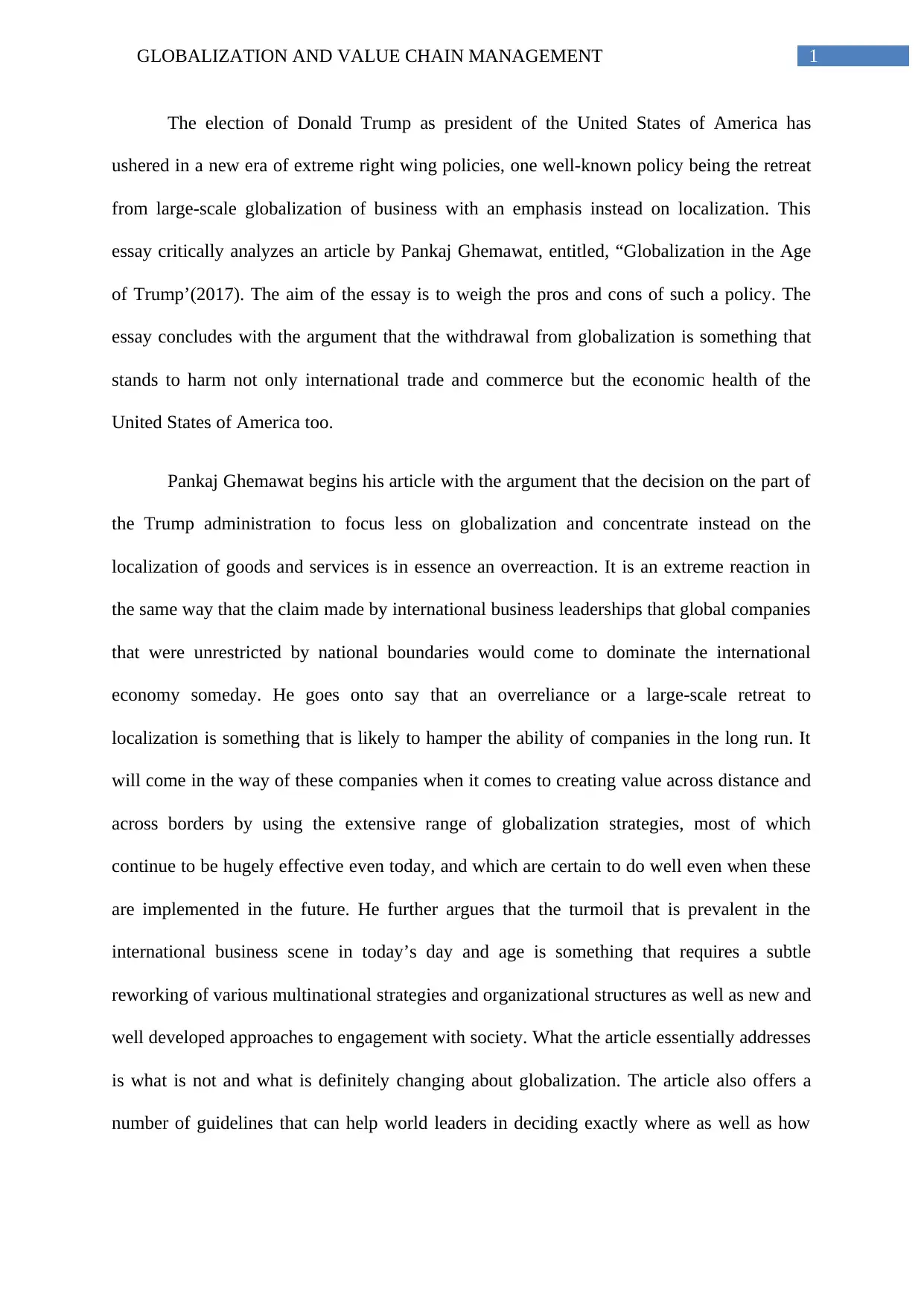
1GLOBALIZATION AND VALUE CHAIN MANAGEMENT
The election of Donald Trump as president of the United States of America has
ushered in a new era of extreme right wing policies, one well-known policy being the retreat
from large-scale globalization of business with an emphasis instead on localization. This
essay critically analyzes an article by Pankaj Ghemawat, entitled, “Globalization in the Age
of Trump’(2017). The aim of the essay is to weigh the pros and cons of such a policy. The
essay concludes with the argument that the withdrawal from globalization is something that
stands to harm not only international trade and commerce but the economic health of the
United States of America too.
Pankaj Ghemawat begins his article with the argument that the decision on the part of
the Trump administration to focus less on globalization and concentrate instead on the
localization of goods and services is in essence an overreaction. It is an extreme reaction in
the same way that the claim made by international business leaderships that global companies
that were unrestricted by national boundaries would come to dominate the international
economy someday. He goes onto say that an overreliance or a large-scale retreat to
localization is something that is likely to hamper the ability of companies in the long run. It
will come in the way of these companies when it comes to creating value across distance and
across borders by using the extensive range of globalization strategies, most of which
continue to be hugely effective even today, and which are certain to do well even when these
are implemented in the future. He further argues that the turmoil that is prevalent in the
international business scene in today’s day and age is something that requires a subtle
reworking of various multinational strategies and organizational structures as well as new and
well developed approaches to engagement with society. What the article essentially addresses
is what is not and what is definitely changing about globalization. The article also offers a
number of guidelines that can help world leaders in deciding exactly where as well as how
The election of Donald Trump as president of the United States of America has
ushered in a new era of extreme right wing policies, one well-known policy being the retreat
from large-scale globalization of business with an emphasis instead on localization. This
essay critically analyzes an article by Pankaj Ghemawat, entitled, “Globalization in the Age
of Trump’(2017). The aim of the essay is to weigh the pros and cons of such a policy. The
essay concludes with the argument that the withdrawal from globalization is something that
stands to harm not only international trade and commerce but the economic health of the
United States of America too.
Pankaj Ghemawat begins his article with the argument that the decision on the part of
the Trump administration to focus less on globalization and concentrate instead on the
localization of goods and services is in essence an overreaction. It is an extreme reaction in
the same way that the claim made by international business leaderships that global companies
that were unrestricted by national boundaries would come to dominate the international
economy someday. He goes onto say that an overreliance or a large-scale retreat to
localization is something that is likely to hamper the ability of companies in the long run. It
will come in the way of these companies when it comes to creating value across distance and
across borders by using the extensive range of globalization strategies, most of which
continue to be hugely effective even today, and which are certain to do well even when these
are implemented in the future. He further argues that the turmoil that is prevalent in the
international business scene in today’s day and age is something that requires a subtle
reworking of various multinational strategies and organizational structures as well as new and
well developed approaches to engagement with society. What the article essentially addresses
is what is not and what is definitely changing about globalization. The article also offers a
number of guidelines that can help world leaders in deciding exactly where as well as how
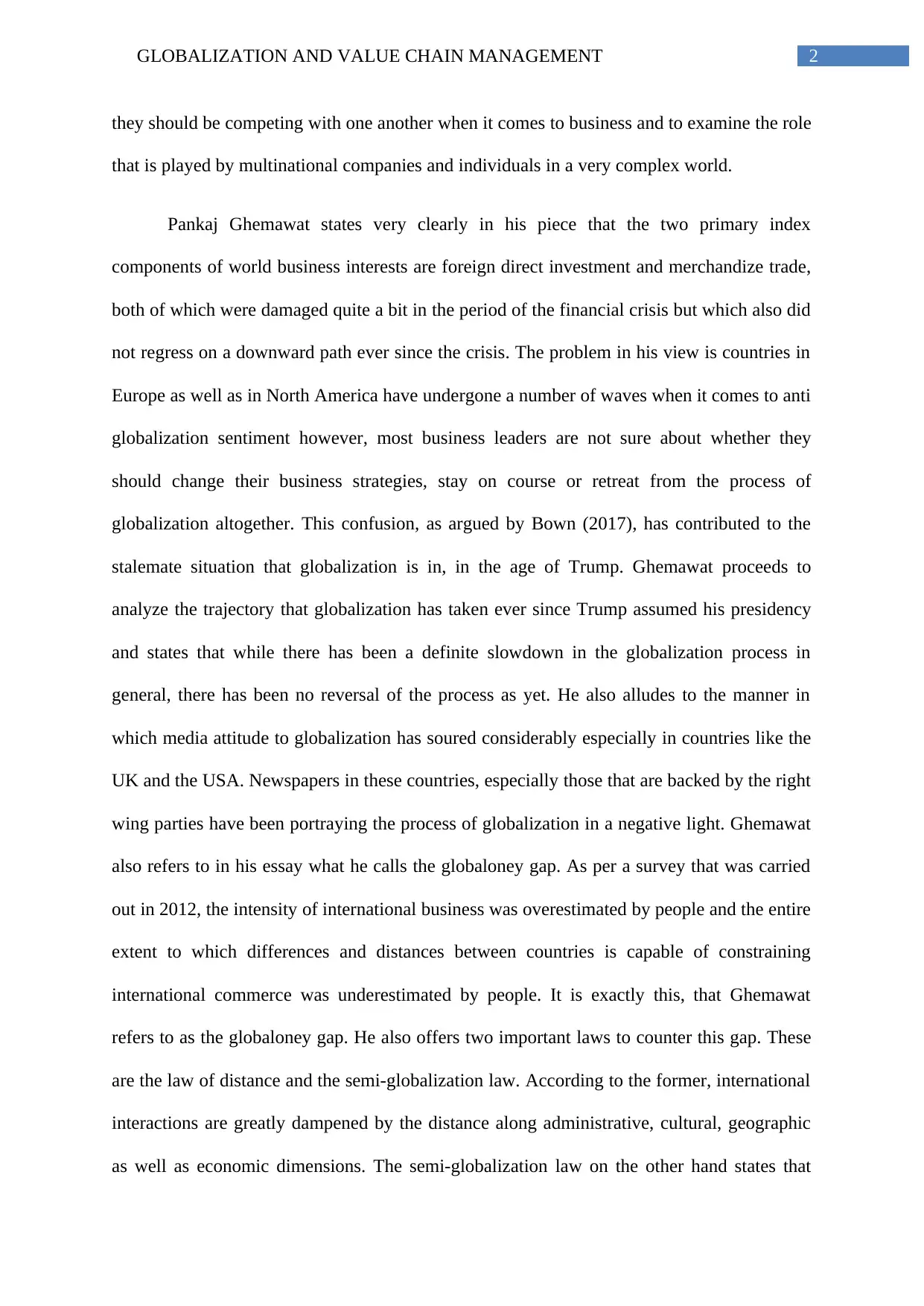
2GLOBALIZATION AND VALUE CHAIN MANAGEMENT
they should be competing with one another when it comes to business and to examine the role
that is played by multinational companies and individuals in a very complex world.
Pankaj Ghemawat states very clearly in his piece that the two primary index
components of world business interests are foreign direct investment and merchandize trade,
both of which were damaged quite a bit in the period of the financial crisis but which also did
not regress on a downward path ever since the crisis. The problem in his view is countries in
Europe as well as in North America have undergone a number of waves when it comes to anti
globalization sentiment however, most business leaders are not sure about whether they
should change their business strategies, stay on course or retreat from the process of
globalization altogether. This confusion, as argued by Bown (2017), has contributed to the
stalemate situation that globalization is in, in the age of Trump. Ghemawat proceeds to
analyze the trajectory that globalization has taken ever since Trump assumed his presidency
and states that while there has been a definite slowdown in the globalization process in
general, there has been no reversal of the process as yet. He also alludes to the manner in
which media attitude to globalization has soured considerably especially in countries like the
UK and the USA. Newspapers in these countries, especially those that are backed by the right
wing parties have been portraying the process of globalization in a negative light. Ghemawat
also refers to in his essay what he calls the globaloney gap. As per a survey that was carried
out in 2012, the intensity of international business was overestimated by people and the entire
extent to which differences and distances between countries is capable of constraining
international commerce was underestimated by people. It is exactly this, that Ghemawat
refers to as the globaloney gap. He also offers two important laws to counter this gap. These
are the law of distance and the semi-globalization law. According to the former, international
interactions are greatly dampened by the distance along administrative, cultural, geographic
as well as economic dimensions. The semi-globalization law on the other hand states that
they should be competing with one another when it comes to business and to examine the role
that is played by multinational companies and individuals in a very complex world.
Pankaj Ghemawat states very clearly in his piece that the two primary index
components of world business interests are foreign direct investment and merchandize trade,
both of which were damaged quite a bit in the period of the financial crisis but which also did
not regress on a downward path ever since the crisis. The problem in his view is countries in
Europe as well as in North America have undergone a number of waves when it comes to anti
globalization sentiment however, most business leaders are not sure about whether they
should change their business strategies, stay on course or retreat from the process of
globalization altogether. This confusion, as argued by Bown (2017), has contributed to the
stalemate situation that globalization is in, in the age of Trump. Ghemawat proceeds to
analyze the trajectory that globalization has taken ever since Trump assumed his presidency
and states that while there has been a definite slowdown in the globalization process in
general, there has been no reversal of the process as yet. He also alludes to the manner in
which media attitude to globalization has soured considerably especially in countries like the
UK and the USA. Newspapers in these countries, especially those that are backed by the right
wing parties have been portraying the process of globalization in a negative light. Ghemawat
also refers to in his essay what he calls the globaloney gap. As per a survey that was carried
out in 2012, the intensity of international business was overestimated by people and the entire
extent to which differences and distances between countries is capable of constraining
international commerce was underestimated by people. It is exactly this, that Ghemawat
refers to as the globaloney gap. He also offers two important laws to counter this gap. These
are the law of distance and the semi-globalization law. According to the former, international
interactions are greatly dampened by the distance along administrative, cultural, geographic
as well as economic dimensions. The semi-globalization law on the other hand states that
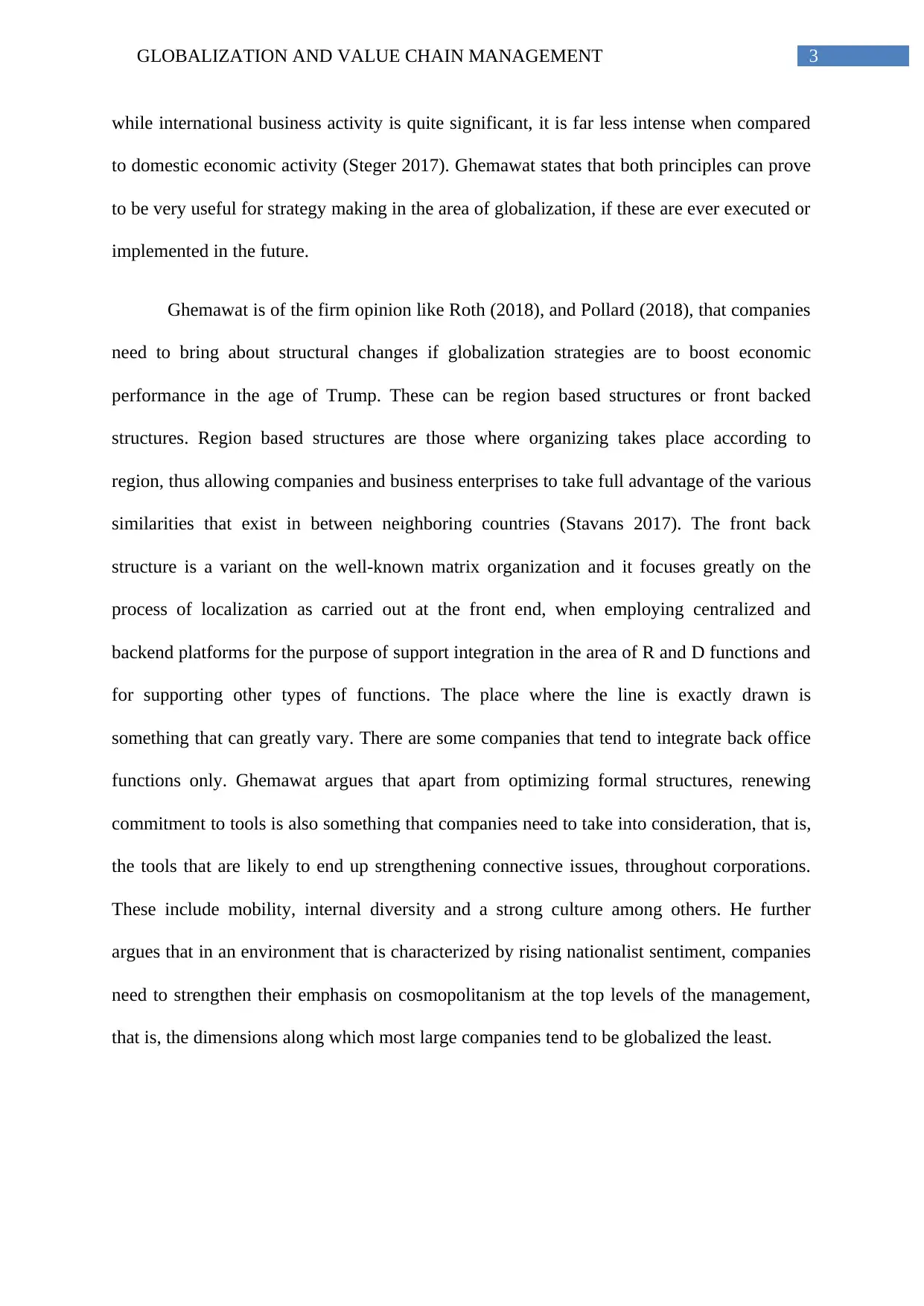
3GLOBALIZATION AND VALUE CHAIN MANAGEMENT
while international business activity is quite significant, it is far less intense when compared
to domestic economic activity (Steger 2017). Ghemawat states that both principles can prove
to be very useful for strategy making in the area of globalization, if these are ever executed or
implemented in the future.
Ghemawat is of the firm opinion like Roth (2018), and Pollard (2018), that companies
need to bring about structural changes if globalization strategies are to boost economic
performance in the age of Trump. These can be region based structures or front backed
structures. Region based structures are those where organizing takes place according to
region, thus allowing companies and business enterprises to take full advantage of the various
similarities that exist in between neighboring countries (Stavans 2017). The front back
structure is a variant on the well-known matrix organization and it focuses greatly on the
process of localization as carried out at the front end, when employing centralized and
backend platforms for the purpose of support integration in the area of R and D functions and
for supporting other types of functions. The place where the line is exactly drawn is
something that can greatly vary. There are some companies that tend to integrate back office
functions only. Ghemawat argues that apart from optimizing formal structures, renewing
commitment to tools is also something that companies need to take into consideration, that is,
the tools that are likely to end up strengthening connective issues, throughout corporations.
These include mobility, internal diversity and a strong culture among others. He further
argues that in an environment that is characterized by rising nationalist sentiment, companies
need to strengthen their emphasis on cosmopolitanism at the top levels of the management,
that is, the dimensions along which most large companies tend to be globalized the least.
while international business activity is quite significant, it is far less intense when compared
to domestic economic activity (Steger 2017). Ghemawat states that both principles can prove
to be very useful for strategy making in the area of globalization, if these are ever executed or
implemented in the future.
Ghemawat is of the firm opinion like Roth (2018), and Pollard (2018), that companies
need to bring about structural changes if globalization strategies are to boost economic
performance in the age of Trump. These can be region based structures or front backed
structures. Region based structures are those where organizing takes place according to
region, thus allowing companies and business enterprises to take full advantage of the various
similarities that exist in between neighboring countries (Stavans 2017). The front back
structure is a variant on the well-known matrix organization and it focuses greatly on the
process of localization as carried out at the front end, when employing centralized and
backend platforms for the purpose of support integration in the area of R and D functions and
for supporting other types of functions. The place where the line is exactly drawn is
something that can greatly vary. There are some companies that tend to integrate back office
functions only. Ghemawat argues that apart from optimizing formal structures, renewing
commitment to tools is also something that companies need to take into consideration, that is,
the tools that are likely to end up strengthening connective issues, throughout corporations.
These include mobility, internal diversity and a strong culture among others. He further
argues that in an environment that is characterized by rising nationalist sentiment, companies
need to strengthen their emphasis on cosmopolitanism at the top levels of the management,
that is, the dimensions along which most large companies tend to be globalized the least.
Secure Best Marks with AI Grader
Need help grading? Try our AI Grader for instant feedback on your assignments.
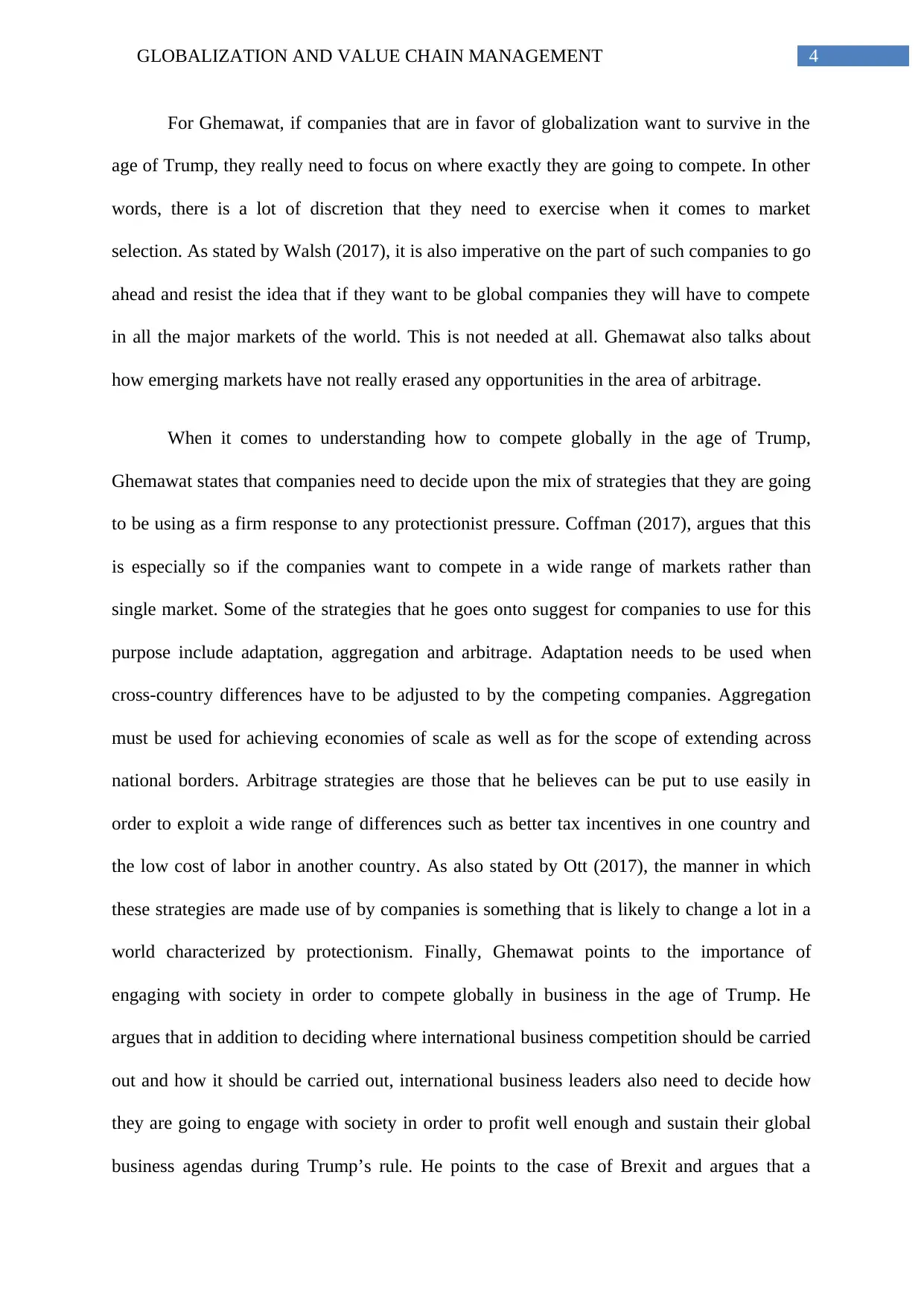
4GLOBALIZATION AND VALUE CHAIN MANAGEMENT
For Ghemawat, if companies that are in favor of globalization want to survive in the
age of Trump, they really need to focus on where exactly they are going to compete. In other
words, there is a lot of discretion that they need to exercise when it comes to market
selection. As stated by Walsh (2017), it is also imperative on the part of such companies to go
ahead and resist the idea that if they want to be global companies they will have to compete
in all the major markets of the world. This is not needed at all. Ghemawat also talks about
how emerging markets have not really erased any opportunities in the area of arbitrage.
When it comes to understanding how to compete globally in the age of Trump,
Ghemawat states that companies need to decide upon the mix of strategies that they are going
to be using as a firm response to any protectionist pressure. Coffman (2017), argues that this
is especially so if the companies want to compete in a wide range of markets rather than
single market. Some of the strategies that he goes onto suggest for companies to use for this
purpose include adaptation, aggregation and arbitrage. Adaptation needs to be used when
cross-country differences have to be adjusted to by the competing companies. Aggregation
must be used for achieving economies of scale as well as for the scope of extending across
national borders. Arbitrage strategies are those that he believes can be put to use easily in
order to exploit a wide range of differences such as better tax incentives in one country and
the low cost of labor in another country. As also stated by Ott (2017), the manner in which
these strategies are made use of by companies is something that is likely to change a lot in a
world characterized by protectionism. Finally, Ghemawat points to the importance of
engaging with society in order to compete globally in business in the age of Trump. He
argues that in addition to deciding where international business competition should be carried
out and how it should be carried out, international business leaders also need to decide how
they are going to engage with society in order to profit well enough and sustain their global
business agendas during Trump’s rule. He points to the case of Brexit and argues that a
For Ghemawat, if companies that are in favor of globalization want to survive in the
age of Trump, they really need to focus on where exactly they are going to compete. In other
words, there is a lot of discretion that they need to exercise when it comes to market
selection. As stated by Walsh (2017), it is also imperative on the part of such companies to go
ahead and resist the idea that if they want to be global companies they will have to compete
in all the major markets of the world. This is not needed at all. Ghemawat also talks about
how emerging markets have not really erased any opportunities in the area of arbitrage.
When it comes to understanding how to compete globally in the age of Trump,
Ghemawat states that companies need to decide upon the mix of strategies that they are going
to be using as a firm response to any protectionist pressure. Coffman (2017), argues that this
is especially so if the companies want to compete in a wide range of markets rather than
single market. Some of the strategies that he goes onto suggest for companies to use for this
purpose include adaptation, aggregation and arbitrage. Adaptation needs to be used when
cross-country differences have to be adjusted to by the competing companies. Aggregation
must be used for achieving economies of scale as well as for the scope of extending across
national borders. Arbitrage strategies are those that he believes can be put to use easily in
order to exploit a wide range of differences such as better tax incentives in one country and
the low cost of labor in another country. As also stated by Ott (2017), the manner in which
these strategies are made use of by companies is something that is likely to change a lot in a
world characterized by protectionism. Finally, Ghemawat points to the importance of
engaging with society in order to compete globally in business in the age of Trump. He
argues that in addition to deciding where international business competition should be carried
out and how it should be carried out, international business leaders also need to decide how
they are going to engage with society in order to profit well enough and sustain their global
business agendas during Trump’s rule. He points to the case of Brexit and argues that a
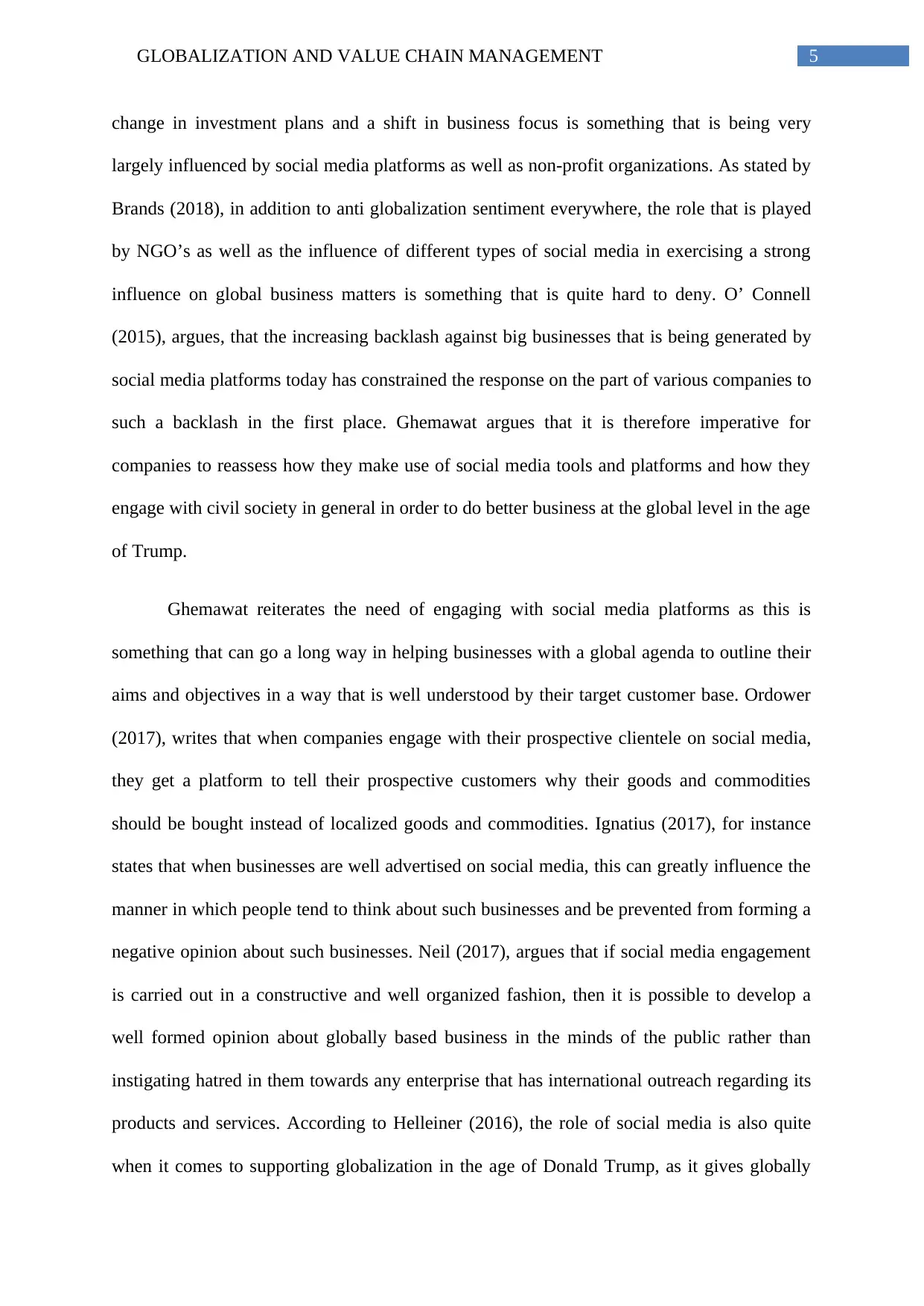
5GLOBALIZATION AND VALUE CHAIN MANAGEMENT
change in investment plans and a shift in business focus is something that is being very
largely influenced by social media platforms as well as non-profit organizations. As stated by
Brands (2018), in addition to anti globalization sentiment everywhere, the role that is played
by NGO’s as well as the influence of different types of social media in exercising a strong
influence on global business matters is something that is quite hard to deny. O’ Connell
(2015), argues, that the increasing backlash against big businesses that is being generated by
social media platforms today has constrained the response on the part of various companies to
such a backlash in the first place. Ghemawat argues that it is therefore imperative for
companies to reassess how they make use of social media tools and platforms and how they
engage with civil society in general in order to do better business at the global level in the age
of Trump.
Ghemawat reiterates the need of engaging with social media platforms as this is
something that can go a long way in helping businesses with a global agenda to outline their
aims and objectives in a way that is well understood by their target customer base. Ordower
(2017), writes that when companies engage with their prospective clientele on social media,
they get a platform to tell their prospective customers why their goods and commodities
should be bought instead of localized goods and commodities. Ignatius (2017), for instance
states that when businesses are well advertised on social media, this can greatly influence the
manner in which people tend to think about such businesses and be prevented from forming a
negative opinion about such businesses. Neil (2017), argues that if social media engagement
is carried out in a constructive and well organized fashion, then it is possible to develop a
well formed opinion about globally based business in the minds of the public rather than
instigating hatred in them towards any enterprise that has international outreach regarding its
products and services. According to Helleiner (2016), the role of social media is also quite
when it comes to supporting globalization in the age of Donald Trump, as it gives globally
change in investment plans and a shift in business focus is something that is being very
largely influenced by social media platforms as well as non-profit organizations. As stated by
Brands (2018), in addition to anti globalization sentiment everywhere, the role that is played
by NGO’s as well as the influence of different types of social media in exercising a strong
influence on global business matters is something that is quite hard to deny. O’ Connell
(2015), argues, that the increasing backlash against big businesses that is being generated by
social media platforms today has constrained the response on the part of various companies to
such a backlash in the first place. Ghemawat argues that it is therefore imperative for
companies to reassess how they make use of social media tools and platforms and how they
engage with civil society in general in order to do better business at the global level in the age
of Trump.
Ghemawat reiterates the need of engaging with social media platforms as this is
something that can go a long way in helping businesses with a global agenda to outline their
aims and objectives in a way that is well understood by their target customer base. Ordower
(2017), writes that when companies engage with their prospective clientele on social media,
they get a platform to tell their prospective customers why their goods and commodities
should be bought instead of localized goods and commodities. Ignatius (2017), for instance
states that when businesses are well advertised on social media, this can greatly influence the
manner in which people tend to think about such businesses and be prevented from forming a
negative opinion about such businesses. Neil (2017), argues that if social media engagement
is carried out in a constructive and well organized fashion, then it is possible to develop a
well formed opinion about globally based business in the minds of the public rather than
instigating hatred in them towards any enterprise that has international outreach regarding its
products and services. According to Helleiner (2016), the role of social media is also quite
when it comes to supporting globalization in the age of Donald Trump, as it gives globally
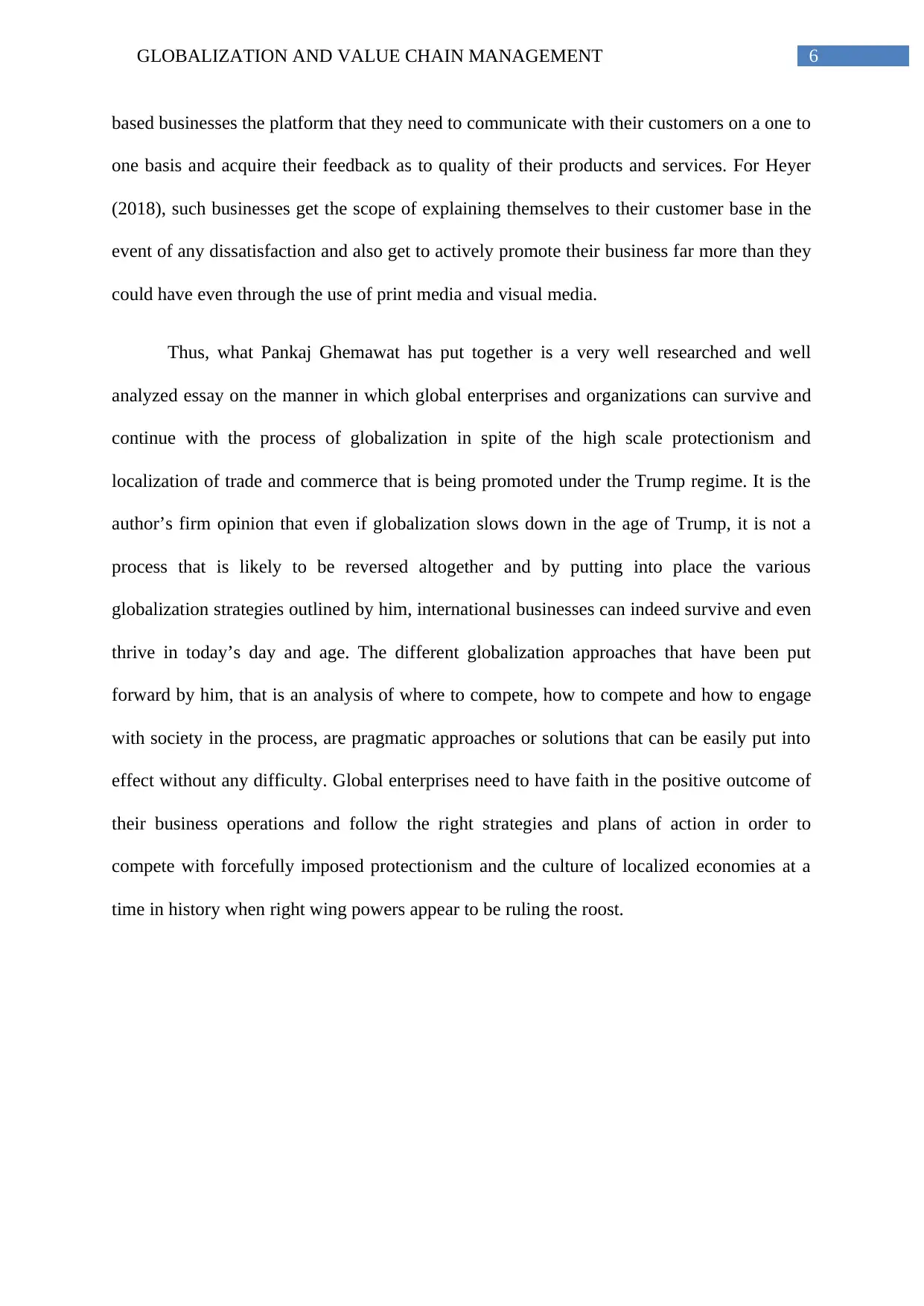
6GLOBALIZATION AND VALUE CHAIN MANAGEMENT
based businesses the platform that they need to communicate with their customers on a one to
one basis and acquire their feedback as to quality of their products and services. For Heyer
(2018), such businesses get the scope of explaining themselves to their customer base in the
event of any dissatisfaction and also get to actively promote their business far more than they
could have even through the use of print media and visual media.
Thus, what Pankaj Ghemawat has put together is a very well researched and well
analyzed essay on the manner in which global enterprises and organizations can survive and
continue with the process of globalization in spite of the high scale protectionism and
localization of trade and commerce that is being promoted under the Trump regime. It is the
author’s firm opinion that even if globalization slows down in the age of Trump, it is not a
process that is likely to be reversed altogether and by putting into place the various
globalization strategies outlined by him, international businesses can indeed survive and even
thrive in today’s day and age. The different globalization approaches that have been put
forward by him, that is an analysis of where to compete, how to compete and how to engage
with society in the process, are pragmatic approaches or solutions that can be easily put into
effect without any difficulty. Global enterprises need to have faith in the positive outcome of
their business operations and follow the right strategies and plans of action in order to
compete with forcefully imposed protectionism and the culture of localized economies at a
time in history when right wing powers appear to be ruling the roost.
based businesses the platform that they need to communicate with their customers on a one to
one basis and acquire their feedback as to quality of their products and services. For Heyer
(2018), such businesses get the scope of explaining themselves to their customer base in the
event of any dissatisfaction and also get to actively promote their business far more than they
could have even through the use of print media and visual media.
Thus, what Pankaj Ghemawat has put together is a very well researched and well
analyzed essay on the manner in which global enterprises and organizations can survive and
continue with the process of globalization in spite of the high scale protectionism and
localization of trade and commerce that is being promoted under the Trump regime. It is the
author’s firm opinion that even if globalization slows down in the age of Trump, it is not a
process that is likely to be reversed altogether and by putting into place the various
globalization strategies outlined by him, international businesses can indeed survive and even
thrive in today’s day and age. The different globalization approaches that have been put
forward by him, that is an analysis of where to compete, how to compete and how to engage
with society in the process, are pragmatic approaches or solutions that can be easily put into
effect without any difficulty. Global enterprises need to have faith in the positive outcome of
their business operations and follow the right strategies and plans of action in order to
compete with forcefully imposed protectionism and the culture of localized economies at a
time in history when right wing powers appear to be ruling the roost.
Paraphrase This Document
Need a fresh take? Get an instant paraphrase of this document with our AI Paraphraser
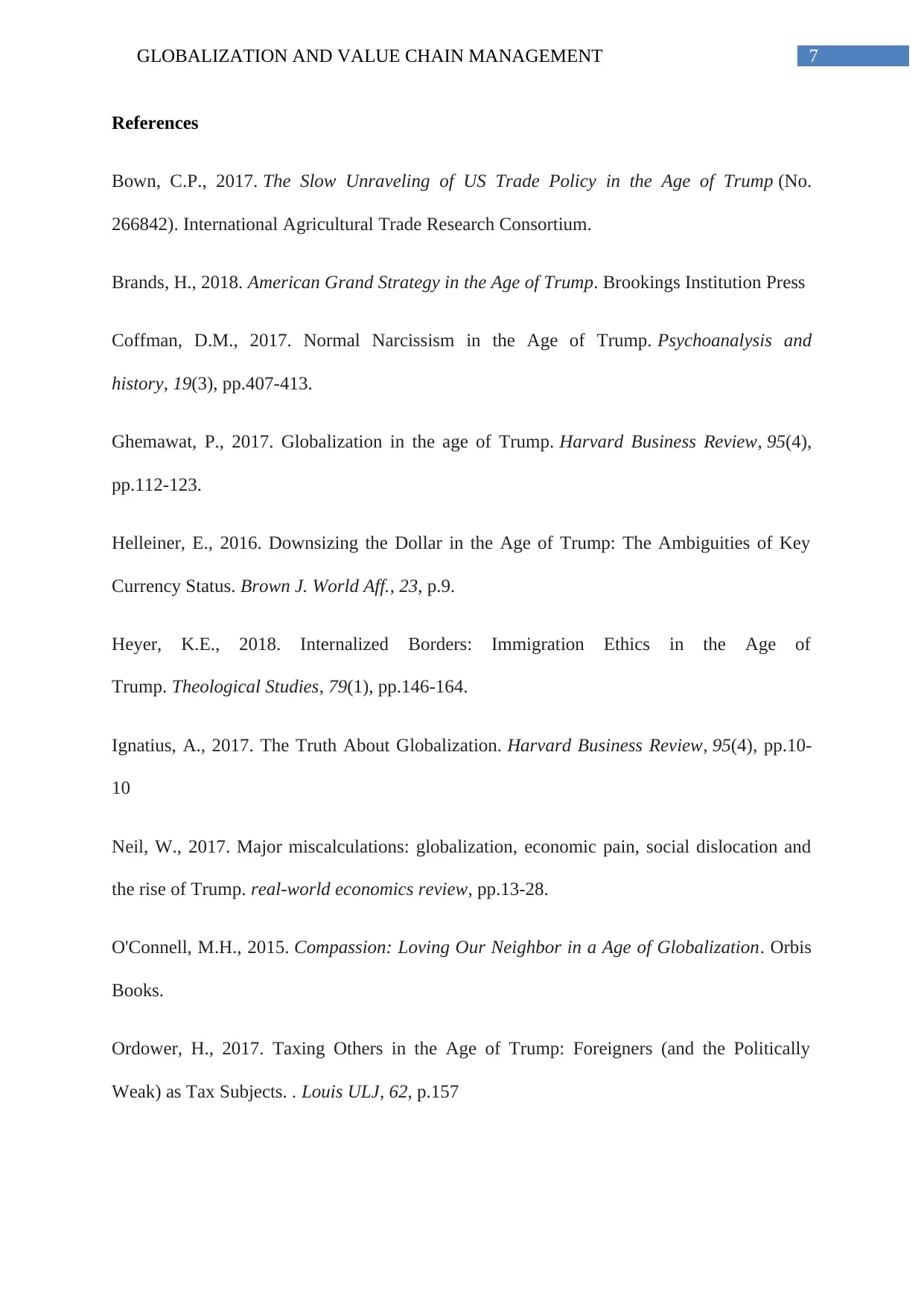
7GLOBALIZATION AND VALUE CHAIN MANAGEMENT
References
Bown, C.P., 2017. The Slow Unraveling of US Trade Policy in the Age of Trump (No.
266842). International Agricultural Trade Research Consortium.
Brands, H., 2018. American Grand Strategy in the Age of Trump. Brookings Institution Press
Coffman, D.M., 2017. Normal Narcissism in the Age of Trump. Psychoanalysis and
history, 19(3), pp.407-413.
Ghemawat, P., 2017. Globalization in the age of Trump. Harvard Business Review, 95(4),
pp.112-123.
Helleiner, E., 2016. Downsizing the Dollar in the Age of Trump: The Ambiguities of Key
Currency Status. Brown J. World Aff., 23, p.9.
Heyer, K.E., 2018. Internalized Borders: Immigration Ethics in the Age of
Trump. Theological Studies, 79(1), pp.146-164.
Ignatius, A., 2017. The Truth About Globalization. Harvard Business Review, 95(4), pp.10-
10
Neil, W., 2017. Major miscalculations: globalization, economic pain, social dislocation and
the rise of Trump. real-world economics review, pp.13-28.
O'Connell, M.H., 2015. Compassion: Loving Our Neighbor in a Age of Globalization. Orbis
Books.
Ordower, H., 2017. Taxing Others in the Age of Trump: Foreigners (and the Politically
Weak) as Tax Subjects. . Louis ULJ, 62, p.157
References
Bown, C.P., 2017. The Slow Unraveling of US Trade Policy in the Age of Trump (No.
266842). International Agricultural Trade Research Consortium.
Brands, H., 2018. American Grand Strategy in the Age of Trump. Brookings Institution Press
Coffman, D.M., 2017. Normal Narcissism in the Age of Trump. Psychoanalysis and
history, 19(3), pp.407-413.
Ghemawat, P., 2017. Globalization in the age of Trump. Harvard Business Review, 95(4),
pp.112-123.
Helleiner, E., 2016. Downsizing the Dollar in the Age of Trump: The Ambiguities of Key
Currency Status. Brown J. World Aff., 23, p.9.
Heyer, K.E., 2018. Internalized Borders: Immigration Ethics in the Age of
Trump. Theological Studies, 79(1), pp.146-164.
Ignatius, A., 2017. The Truth About Globalization. Harvard Business Review, 95(4), pp.10-
10
Neil, W., 2017. Major miscalculations: globalization, economic pain, social dislocation and
the rise of Trump. real-world economics review, pp.13-28.
O'Connell, M.H., 2015. Compassion: Loving Our Neighbor in a Age of Globalization. Orbis
Books.
Ordower, H., 2017. Taxing Others in the Age of Trump: Foreigners (and the Politically
Weak) as Tax Subjects. . Louis ULJ, 62, p.157
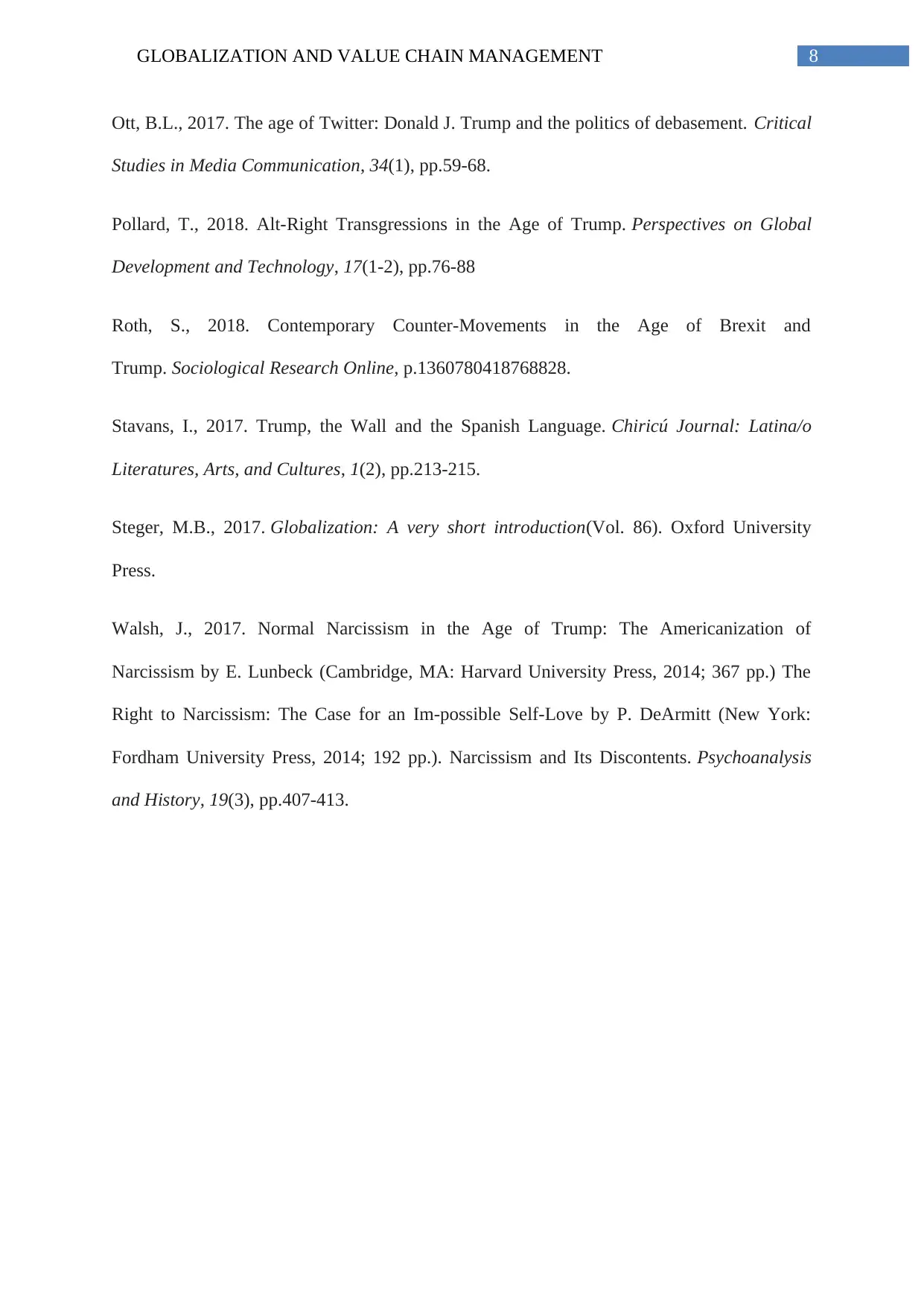
8GLOBALIZATION AND VALUE CHAIN MANAGEMENT
Ott, B.L., 2017. The age of Twitter: Donald J. Trump and the politics of debasement. Critical
Studies in Media Communication, 34(1), pp.59-68.
Pollard, T., 2018. Alt-Right Transgressions in the Age of Trump. Perspectives on Global
Development and Technology, 17(1-2), pp.76-88
Roth, S., 2018. Contemporary Counter-Movements in the Age of Brexit and
Trump. Sociological Research Online, p.1360780418768828.
Stavans, I., 2017. Trump, the Wall and the Spanish Language. Chiricú Journal: Latina/o
Literatures, Arts, and Cultures, 1(2), pp.213-215.
Steger, M.B., 2017. Globalization: A very short introduction(Vol. 86). Oxford University
Press.
Walsh, J., 2017. Normal Narcissism in the Age of Trump: The Americanization of
Narcissism by E. Lunbeck (Cambridge, MA: Harvard University Press, 2014; 367 pp.) The
Right to Narcissism: The Case for an Im-possible Self-Love by P. DeArmitt (New York:
Fordham University Press, 2014; 192 pp.). Narcissism and Its Discontents. Psychoanalysis
and History, 19(3), pp.407-413.
Ott, B.L., 2017. The age of Twitter: Donald J. Trump and the politics of debasement. Critical
Studies in Media Communication, 34(1), pp.59-68.
Pollard, T., 2018. Alt-Right Transgressions in the Age of Trump. Perspectives on Global
Development and Technology, 17(1-2), pp.76-88
Roth, S., 2018. Contemporary Counter-Movements in the Age of Brexit and
Trump. Sociological Research Online, p.1360780418768828.
Stavans, I., 2017. Trump, the Wall and the Spanish Language. Chiricú Journal: Latina/o
Literatures, Arts, and Cultures, 1(2), pp.213-215.
Steger, M.B., 2017. Globalization: A very short introduction(Vol. 86). Oxford University
Press.
Walsh, J., 2017. Normal Narcissism in the Age of Trump: The Americanization of
Narcissism by E. Lunbeck (Cambridge, MA: Harvard University Press, 2014; 367 pp.) The
Right to Narcissism: The Case for an Im-possible Self-Love by P. DeArmitt (New York:
Fordham University Press, 2014; 192 pp.). Narcissism and Its Discontents. Psychoanalysis
and History, 19(3), pp.407-413.
1 out of 9
Related Documents
Your All-in-One AI-Powered Toolkit for Academic Success.
+13062052269
info@desklib.com
Available 24*7 on WhatsApp / Email
![[object Object]](/_next/static/media/star-bottom.7253800d.svg)
Unlock your academic potential
© 2024 | Zucol Services PVT LTD | All rights reserved.



